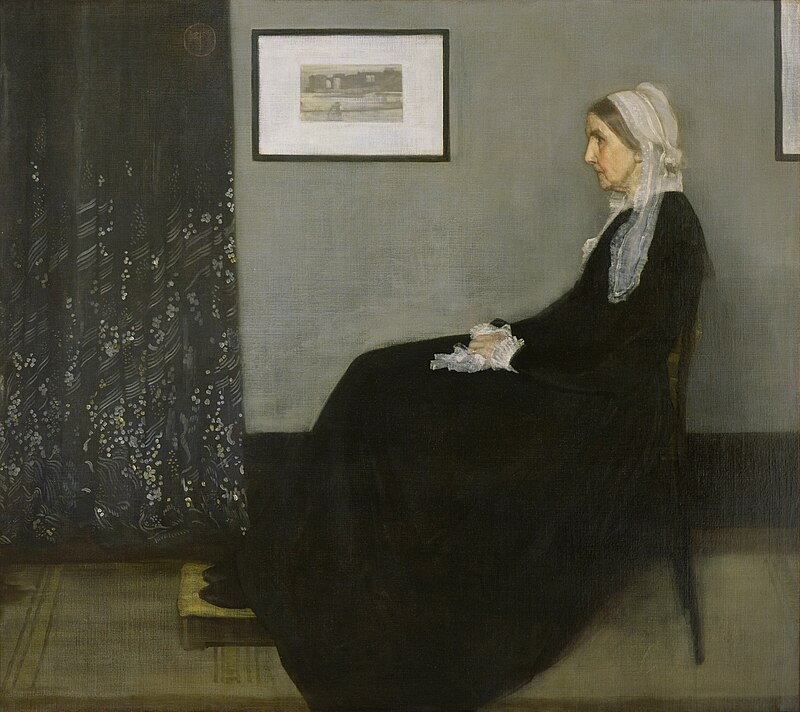
Whistler’s Mother: An Icon of Sublime Serenity and Timeless Beauty
In the world of art, certain paintings have the power to transcend time and capture the essence of human emotion. One such masterpiece is “Whistler’s Mother,” also known as “Arrangement in Grey and Black No. 1,” painted by James McNeill Whistler in 1871. This iconic painting is an exquisite portrayal of a mother’s love, resonating with audiences across generations for its timeless beauty and emotional depth. Let us delve into the history, significance, and enduring legacy of this beloved artwork.
- The Artist: James McNeill Whistler
James McNeill Whistler (1834-1903) was an American-born painter who spent most of his life in Europe, particularly in London. He was a leading figure in the Aesthetic Movement and was known for his innovative approach to art, which emphasized the harmony of color and form. Whistler’s art often revolved around portraits, landscapes, and nocturnes, characterized by their subtle beauty and delicate tones.
The Meaning of “Whistler’s Mother”:
“Whistler’s Mother,” also known as “Arrangement in Grey and Black No. 1,” depicts the artist’s mother, Anna McNeill Whistler, seated on a wooden chair in their London home. The painting is characterized by its monochromatic palette, primarily using varying shades of grey, black, and white. Its simplicity and lack of any significant background details draw the viewer’s attention solely to the central figure, Anna Whistler.
The meaning of the painting goes beyond being a conventional portrait. Whistler intended to capture the essence of motherhood, portraying the emotions of maternal love, devotion, and serenity. Anna Whistler’s calm and dignified demeanor conveys a sense of inner peace, while her clasped hands and thoughtful expression evoke a feeling of maternal tenderness.
The Worth of “Whistler’s Mother”:
The artistic and cultural value of “Whistler’s Mother” is immeasurable. As one of James McNeill Whistler’s most famous works, the painting holds a significant place in art history. It debuted at the Royal Academy of Arts in London in 1872, garnering praise and recognition for its emotional depth and innovative approach.
From a monetary standpoint, “Whistler’s Mother” is priceless. It is currently housed in the Musée d’Orsay in Paris, which is one of the most prestigious art museums in the world. As a piece of cultural heritage, it is considered a national treasure and is unlikely to be sold.
The Message of “Whistler’s Mother”:
Beyond the portrayal of maternal love, “Whistler’s Mother” conveys universal themes that resonate with viewers across time. The painting embodies the timeless qualities of motherhood, sacrifice, and strength. The subdued color scheme and lack of overt details in the background emphasize the emotional core of the artwork, inviting viewers to connect with the subject and reflect on the significance of mother-child relationships.
Moreover, “Whistler’s Mother” subtly addresses the themes of aging, contemplation, and the passage of time. It captures a poignant moment in a mother’s life, inviting viewers to contemplate their own relationships with their parents or loved ones.
The Enduring Fame of “Whistler’s Mother”:
Several factors contribute to the enduring fame of “Whistler’s Mother.” Firstly, James McNeill Whistler’s innovative artistic style, characterized by harmony in color and form, made his works stand out in the art world. The painting’s emotional intensity and universal themes resonate with audiences from diverse cultural backgrounds.
Secondly, “Whistler’s Mother” has made appearances in popular culture, further solidifying its iconic status. Reproductions and references to the painting in advertisements, cartoons, movies, and television shows have made it recognizable to a broader audience.
Lastly, the painting’s historical and cultural significance has ensured its prominent place in art exhibitions and museums worldwide. Its enduring fame is a testament to the power of art to capture human emotion and transcend time.
- The Creation of “Whistler’s Mother”
Whistler’s most renowned work, “Whistler’s Mother,” was a portrait of his mother, Anna McNeill Whistler, painted in their London home. Originally titled “Arrangement in Grey and Black No. 1,” the painting captures Anna Whistler sitting on a wooden chair against a plain, dark backdrop. Her serene and dignified demeanor exudes maternal tenderness, with her hands gently clasped in her lap.
The painting is characterized by its monochromatic palette, predominantly varying shades of grey, black, and white. Whistler’s deliberate choice to use this subdued color scheme emphasizes the simplicity and timelessness of the moment, drawing attention to the emotions conveyed by the subject.
- The Symbolism and Emotional Depth
Whistler’s masterpiece goes beyond being a mere portrait; it symbolizes the universal essence of motherhood, capturing the devotion and love between a mother and her child. The calm and tranquil atmosphere evokes a sense of inner peace, allowing the viewer to connect emotionally with the subject and appreciate the beauty of maternal affection.
The absence of any specific details in the background allows the focus to remain solely on the central figure, Anna Whistler. Whistler intended to emphasize the emotional core of the painting, providing a powerful portrayal of a mother’s unconditional love, sacrifice, and unwavering strength.
- Enduring Legacy and Cultural Impact
“Whistler’s Mother” debuted at the Royal Academy of Arts in London in 1872, gaining instant recognition and praise. Its emotionally charged simplicity and powerful portrayal of a mother’s love resonated with viewers, making it an enduring symbol of timeless beauty and maternal tenderness.
Today, “Whistler’s Mother” holds a treasured place in art history and popular culture. Reproductions and references to the painting have appeared in various forms, from parodies in advertisements and cartoons to appearances in movies and television shows. This further solidifies its status as an iconic and recognizable work of art.
- Conservation and Exhibition
Over the years, “Whistler’s Mother” has been exhibited in renowned galleries and museums around the world, making it accessible to art enthusiasts everywhere. To ensure the preservation of this cultural treasure, it has undergone meticulous conservation efforts by experts in art restoration. The aim has been to maintain the integrity of the painting, allowing it to be appreciated by future generations.
“Whistler’s Mother” stands as a timeless testament to the bond between a mother and her child, skillfully captured by James McNeill Whistler’s artistic vision. Its emotional depth and exquisite simplicity continue to touch the hearts of viewers, making it one of the most celebrated masterpieces in the history of art. As long as there are people who appreciate the beauty of human emotion, “Whistler’s Mother” will undoubtedly remain an enduring symbol of sublime serenity and timeless beauty.






